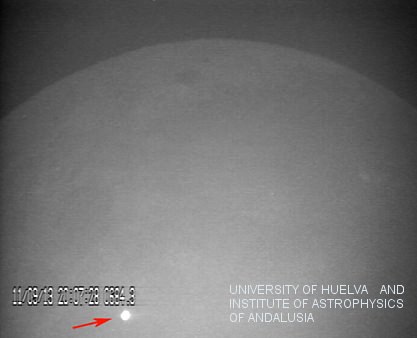Hey, all you astro-photographers/videographers out there: were you shooting the Moon back on September 11, 2013? You may want to review your footage and see if you captured a bright flash which occurred at about 20:07 GMT. Astronomers say a meteorite with the mass of a small car slammed into the Moon at that time and the impact produced a bright flash, and it even would have been easy to spot from the Earth.
According to astronomers Jose M. Madiedo, from the University of Huelva and Jose L. Ortiz, from the Institute of Astrophysics of Andalusia both in Spain, this impact was the longest and brightest confirmed lunar impact flash ever observed, as the “afterglow” of the impact remained visible for 8 seconds.
The astronomers think the bright flash was produced by an impactor of around 400 kg with a width of between 0.6 and 1.4 meters. The rock hit may have hit Mare Nubium at about 61,000 kilometers per hour (38,000 miles per hour) — although the uncertainty of the impact is fairly high, the team says in their paper. But if it is as high as they think, it may have created a new crater with a diameter of around 40 meters. The impact energy was equivalent to an explosion of roughly 15 tons of TNT.
This beats the previous largest impact seen – which occurred just six months earlier in March 2013 – which was estimated to pack as much punch as 5 tons of TNT. Astronomers that explosion was caused by a 40 kg meteoroid measuring 0.3 to 0.4 meters wide, traveling about 90,000 km/hr (56,000 mph.)
How often does an asteroid hit the Moon? Astronomers actually aren’t very sure.
On average, 33 metric tons (73,000 lbs) of meteoroids hit Earth every day, the vast majority of which harmlessly ablates or burns up high in Earth’s atmosphere, never making it to the ground. The Moon, however, has little or no atmosphere, so meteoroids have nothing to stop them from striking the surface.
The lunar impact rate is so uncertain because observations for objects in the mass range of visible impacts from Earth are quite few. But now, astronomers have set up networks of telescopes that can detect them automatically. NASA has the Automated Lunar and Meteor Observatory (ALaMO) at Marshall Space Flight Center, and the Spanish telescopes are part of the Moon Impacts Detection and Analysis System (MIDAS) system.
Lunar meteors hit the ground with so much kinetic energy that they don’t require an oxygen atmosphere to create a visible explosion. The flash of light comes not from combustion but rather from the thermal glow of molten rock and hot vapors at the impact site.
This thermal glow can be detected from Earth as short-duration flashes through telescopes. Generally, these flashes last just a fraction of a second. But the flash detected on September 11, 2013 was much more intense and longer than anything observed before.

“Our telescopes will continue observing the Moon as our meteor cameras monitor the Earth’s atmosphere,” said Madiedo and Ortiz in a press release. “In this way we expect to identify clusters of rocks that could give rise to common impact events on both planetary bodies. We also want to find out where the impacting bodies come from.”
You can read the team’s paper here.


“The astronomers think the bright flash was produced by an impactor of around 400 kg with a width of between 0.6 and 1.4 meters.”
I think the video and story are pretty cool, but no way is that description the “car-sized”. Maybe golf-cart sized. No need to hype the size in the title.
Read more: http://www.universetoday.com/109704/watch-a-car-sized-asteroid-slam-into-the-moon/#ixzz2uGLnotTh
Now THAT would be a cool entry in your observing log!
SciFi short subject: I was out with my telescope adjusting tracking rates. I was looking down at the mount when I saw the light from a bright flash behind me. I spun around and saw a ‘pea’ sized visible red/blue glow in the Apennines Mountains on the moon. Then I punched the replay button on my digital video capture and saw the actual event. I noticed what appeared to be ‘sparks’ rising from the impact site. I observed the new crater for more than three hours before the moon set. That new crater was still glowing! Excited as I was, I decided to image another section of the sky looking for a new comet I’d heard about C2014a-Romanowski/Bendish. I spent the next four hours making a series of exposures in Coma Bernices. Then, just before dawn, the meteor shower began. I saw several bright flashes over the eastern horizon followed several seconds later by distant sonic booms. Are you still there? Why haven’t you responded? I’ve got the news feed up on-line hoping to hea……..
Q: How many large asteroids have you read about at SpaceWeather.com which passed inside the orbital radius of the moon? Were a large enough, fast enough asteroid to impact the moon at just the right angle… just saying~